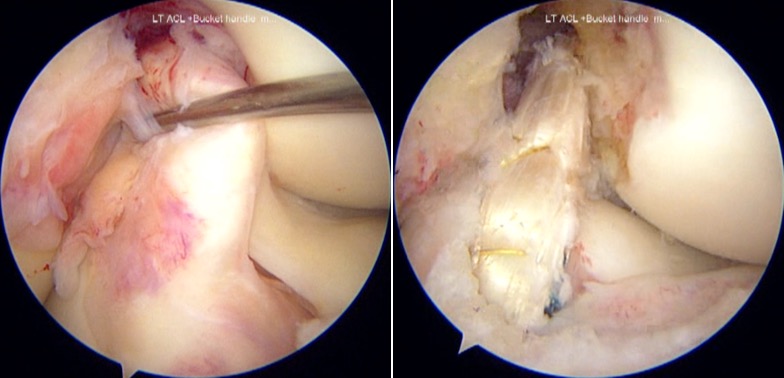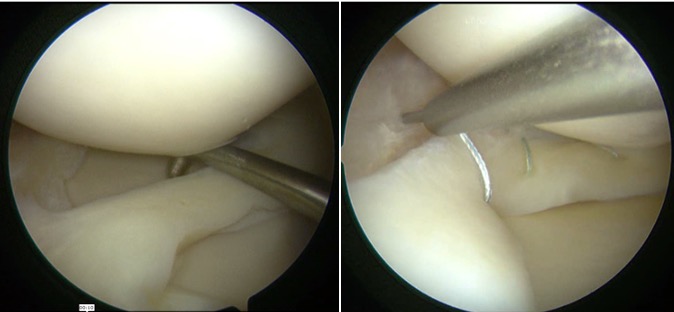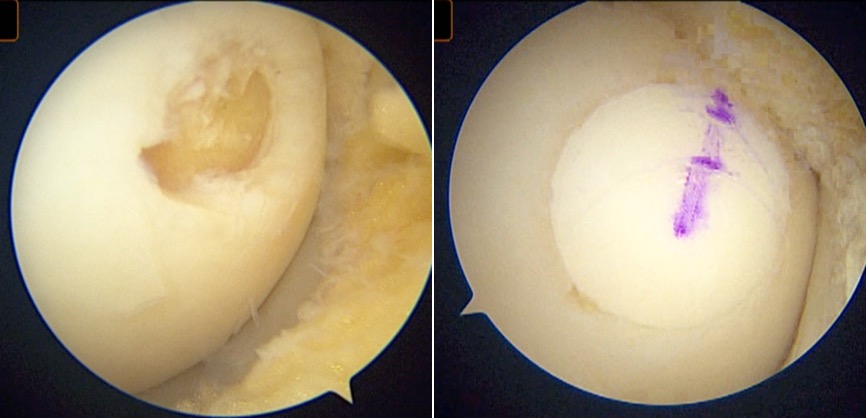There are several conditions of the knee and shoulder joints which can be treated with arthroscopy. Some commonly performed Arthroscopy procedures by Dr. Shekhar are described below.
Arthroscopy
Arthroscopy
Arthroscopy is basically ‘key hole’ surgery. The damaged tissues can be repaired using this technology without having to make large incisions and opening the whole joint. Arthroscopy involves making small cuts in the skin called ‘portals’ and inserting a camera to view the joint on a monitor. Specialized instruments and implants can be inserted into the joint through these small portals. The advantages of Arthroscopic surgery over open surgery include: 1. Lesser pain; 2. Faster recovery; 3. Lesser stiffness; 4. Early discharge from hospital; 5. Greater safety; 6. Improved accuracy. These advantages make arthroscopy a preferred option wherever possible.
Knee Joint: The knee is a very important joint of the body. It is made of up 2 bones: the femur (thigh bone), tibia (shin bone) and patella (knee cap). The knee has 4 main ligaments which provide stability to the joint:
- Anterior Cruciate Ligament (ACL);
- Posterior Cruciate Ligament (PCL);
- Medial Collateral Ligament (MCL);
- Lateral Collateral Ligament (LCL).
There are two cushion like structures between the bones called the meniscus. The bone inside the joint is covered by a smooth lining called the cartilage.
- ACL Surgery: To reconstruct or repair the torn Anterior Cruciate Ligament (ACL). This ligament is the main stabilizer of the knee joint and is important for normal knee function. It commonly gets injured during sports injuries or a road traffic accident. Due to its poor blood supply, the ACL usually does not heal by itself. Injury to the ACL causes instability, i.e., the knee wobbles and patients loses balance while walking or running. A new ligament is created using tendons from the patient’s own leg. This is fixed in the bone using metal or biodegradable implants (screws or buttons). Dr. Shekhar has performed more than 800 ACL reconstructions and even written 2 books on this subject.

- PCL Surgery: The Posterior Cruciate Ligament (PCL) is the strongest ligament in the knee joint and is present on the back-side. It gets injured less frequently. A tear of the PCL causes pain in the front of the knee and some instability (wobbliness). When the instability is severe or there is injury to any other ligament also, surgery is required. Just like the ACL, a new PCL is created using tendons from the patient’s own leg. This is also fixed in the bone using metal or biodegradable implants (screws or buttons).
- Meniscus Surgery: The meniscus is a cartilage disc, which is present in between the bones of the knee joint. There are two menisci in each knee – a medial (inner) and a lateral (outer) meniscus. When seen from the top, they are C shaped and in the cross-section. The meniscus functions as the shock absorber in the knee and reduces wear and tear. The meniscus can tear due to an injury or as an aging related process. The meniscus has very poor blood supply and does not heal after a tear. This torn meniscus can be repaired (stitched) or sometimes removed by arthroscopy. Dr. Shekhar has extensive experience in performing all types of meniscus repairs and published several scientific papers on this topic.
- Cartilage Surgery: The smooth lining of any joint is covered with cartilage. It allows free smooth movements. The cartilage can get damaged due to a trauma, loss of blood supply or old age. Arthroscopy can be used to repair the damaged cartilage by several techniques. Dr. Shekhar has wide experience in repairing cartilage injuries.


Shoulder Joint: The Shoulder joint is a ball and socket joint. It has several muscle attachment all-around it and it a very mobile joint. The shoulder joint can be affected by several conditions but two of them which require arthroscopic surgery are:
- Labral Repair: The ‘labrum’ is a ring of cartilage that surrounds the glenoid (cup) of the shoulder joint. It gets torn when the joint dislocates i.e., the ball comes out of the cup. This happens because of trauma (sports related or road accident) or in epilepsy. The labrum must be stitched back to its original position otherwise the shoulder may keep dislocating again and again. The surgery to stich the labrum is called labral repair. It is done via arthroscopy, without having to open the whole joint. Small bio-degradable implants called suture anchors are used to repair the labrum.
- Rotator Cuff Repair: There are 4 muscles which comprise the rotator cuff of the shoulder joint. The cuff together allows the arm to be lifted upwards against gravity and to rotate inwards or outwards. Rotator cuff tears can occur following a trauma or more commonly, due to age-related wear and tear changes. A rotator cuff tear causes signification pain and loss of shoulder movement. It does tend to heal in some patients but may require surgery is a few patients. Like the labrum, bio-degradable implants called suture anchors are used to repair the rotator cuff tendons.
About Us
We at Sushrut OrthoPlastic Clinic always strive to provide the best possible medical treatment to our patient aiming to achieve the highest possible success rate.
Our Customers
Quick Contacts
- Indravati Colony Chowk, Canal Linking Road, Raipur. PIN 492001.
- Phone : +91 6264411337
- Email : sushrutorthoplastic@gmail.com
Quick Location
- Developed By Online B2B Digital Technology © 2024 – All Rights Reserved
